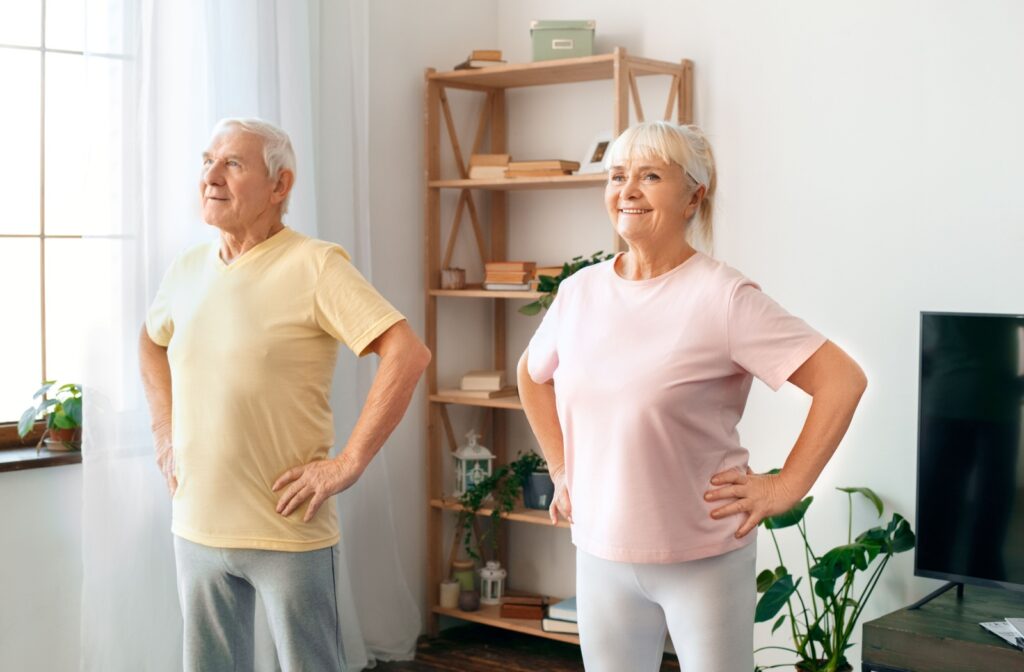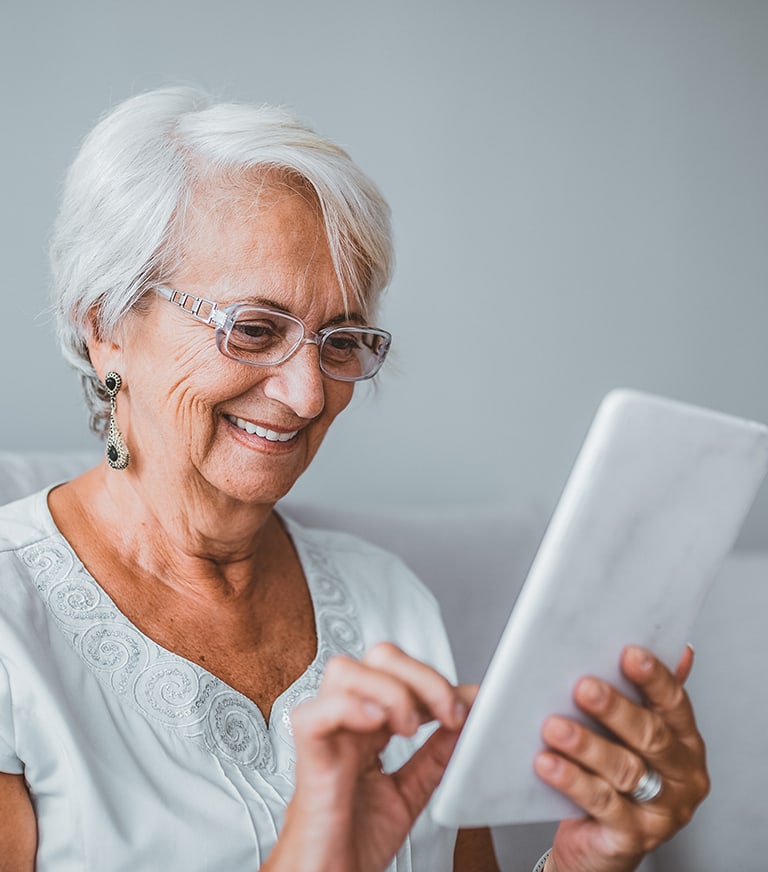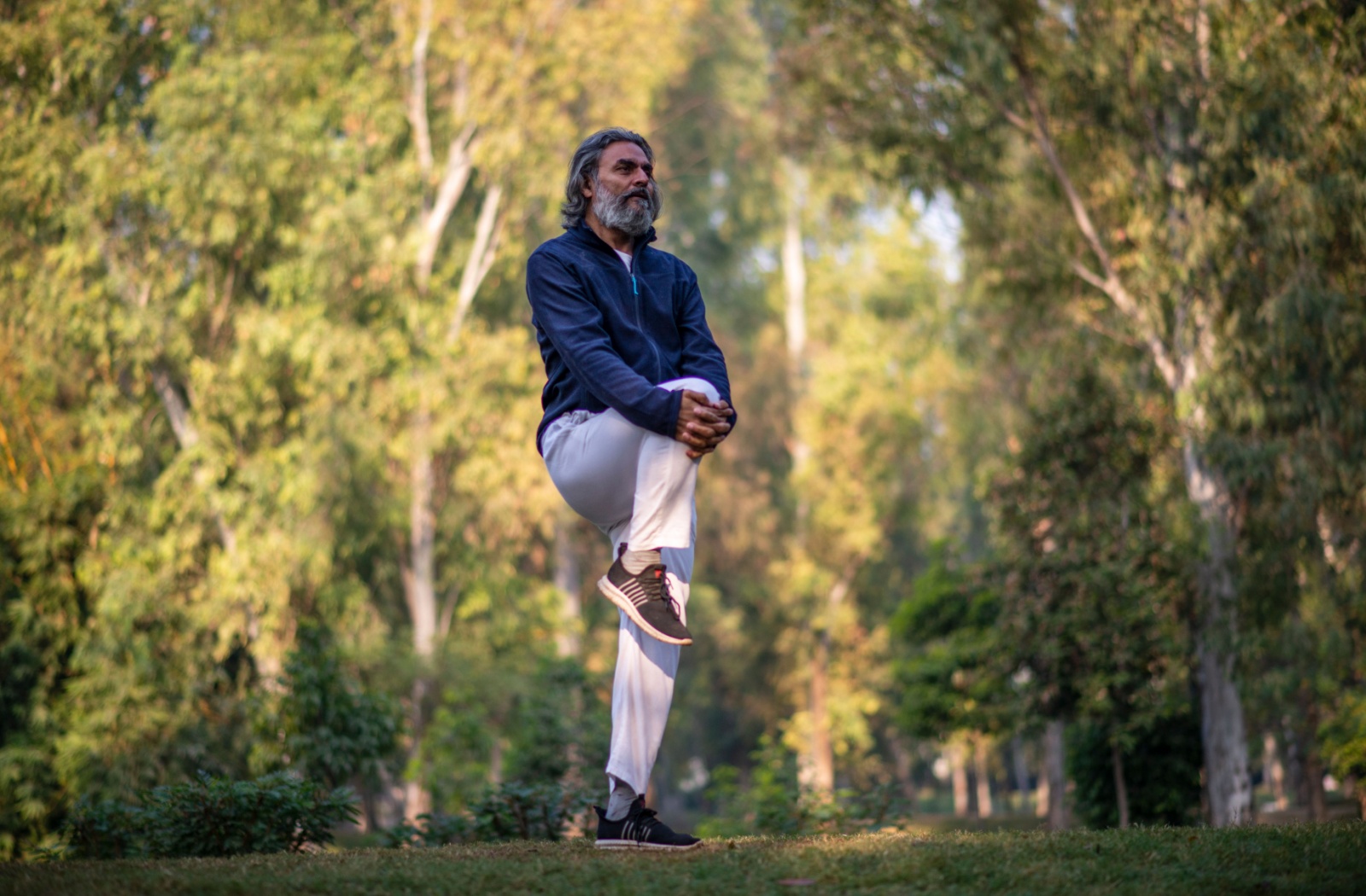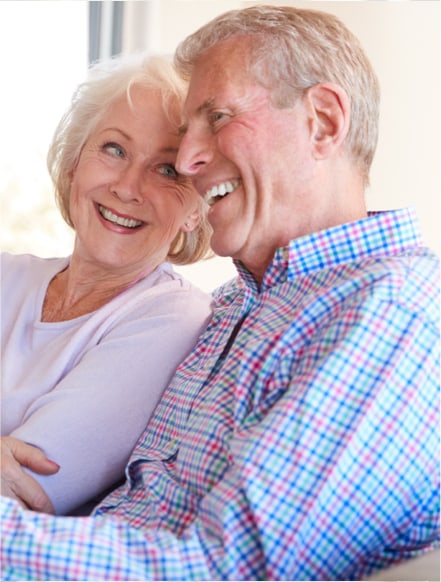Key Takeaways
- Standing exercises help seniors maintain balance, flexibility, and strength for daily activities.
- Always consult your healthcare provider before starting new exercises and prioritize safety.
- Start slowly and listen to your body while staying consistent with your routine.
- Senior living communities can provide supportive environments for maintaining active lifestyles.
Staying active becomes more important as we age, but you don’t need complicated equipment or gym memberships to maintain your health. Standing exercises offer a simple, effective way to keep your body strong and mobile right in your own home.
Here is a simple standing exercise routine you and your loved one can follow:
- 5 minutes of warm-up activities, like walking in place
- 10–30 seconds of single-leg balance per leg
- 10–20 reps of heel-toe walking
- 5–10 minutes of upper body and lower body stretches
- 10–15 reps of front leg raises with a chair for support
- 10–15 reps of wall push-ups
A well-designed standing exercise routine can help seniors in assisted living and memory care maintain strength, balance, and flexibility for daily activities while reducing the risk of falls and injuries.
Why Do Standing Exercises Matter for Senior Health?
Regular physical activity plays a key role in maintaining your independence and quality of life. Standing exercises specifically target the muscles and systems you use every day—from getting up from a chair to walking to the mailbox.
These exercises help strengthen your legs, improve your balance, and keep your joints flexible. When you maintain these abilities, everyday tasks become easier and safer.
Many seniors find that assisted living communities and senior living environments provide the support and motivation they need to stay consistent with their exercise routines. Having access to fitness areas and professionally-led classes can make all the difference in maintaining an active lifestyle.
Safety First: Preparing for Your Exercise Routine
Before you begin any new exercise program, talk with your healthcare provider about what activities are right for you. They can help you understand any limitations and suggest modifications based on your current health status.
Warming up your muscles before exercising helps prevent injury and prepares your body for movement. Even five minutes of gentle preparation can make your workout safer and more effective.
Important Safety Guidelines to Follow
- Focus on breathing naturally throughout your exercises—never hold your breath during movements.
- Keep a sturdy chair or wall nearby for support whenever you need it.
- Start with shorter sessions and fewer repetitions, then gradually increase as your body adapts.
- If something feels uncomfortable or painful, stop and rest.
- Wear comfortable, non-slip shoes and clothes that allow you to move freely.
- Make sure your exercise area is clear of obstacles that could cause you to trip.
Staying Hydrated and Listening to Your Body
Keep a water bottle nearby and take sips throughout your exercise session. Your body’s thirst signals may be less noticeable as you age, so drinking water regularly is important.
Pay attention to how you feel during and after exercising. Some mild muscle soreness the next day is normal, but sharp pain or dizziness means you should stop and possibly consult your doctor.
Rest when you need to—there’s no shame in taking breaks. Consistency matters more than intensity when building a sustainable exercise routine.
Exercise Considerations for Seniors with Health Conditions
Many seniors live with conditions like arthritis, high blood pressure, or diabetes, but these don’t have to prevent you from staying active. You’ll just need to choose exercises that work with your body’s needs.
For those dealing with joint stiffness, gentle movements and stretches can actually help reduce discomfort over time. If you have balance concerns or memory-related challenges, memory care programs often include specialized physical activities designed for cognitive health.
Always work within your comfort zone and modify exercises as needed. The goal is to keep moving safely, not to push through pain or discomfort.
Simple Warm-Up Activities to Get Started
Begin each exercise session with 5 minutes of gentle movement to prepare your muscles and joints. Start by walking in place for a minute or 2, lifting your knees slightly higher than normal walking.
Follow this with some arm circles—reach your arms out to your sides and make small circles forward, then backward. This helps loosen your shoulders and upper body.
Finish your warm-up by gently rotating your ankles and wrists in both directions. These simple movements get your blood flowing and reduce your risk of injury during exercise.
Balance Exercises to Prevent Falls
Balance exercises are particularly important for seniors because they directly help prevent falls. Aim to include balance work in your routine at least 3 times per week.
These exercises don’t require special equipment—just a sturdy chair or wall for support when needed. As your balance improves, you can gradually reduce how much you rely on support.
Single Leg Balance and Heel-to-Toe Walking
Start by standing behind a chair and holding onto the back for support. Lift one foot slightly off the ground and try to balance on the other leg for 10–30 seconds, then switch sides.
For heel-to-toe walking, place one foot directly in front of the other, touching heel to toe. Take 10–20 steps this way, using a wall for support if needed.
These movements complement other leg exercises for seniors you can perform at home.
Gentle Movement Practices Like Tai Chi
Tai chi involves slow, flowing movements that improve balance, flexibility, and coordination. Many communities offer tai chi classes specifically designed for seniors.
The gentle nature of tai chi makes it suitable for most fitness levels. You can start with basic movements and progress at your own pace.
Even practicing a few simple tai chi movements at home can help improve your balance and reduce stress. The focus on controlled movement and breathing provides both physical and mental benefits.
Flexibility Exercises for Daily Movement
Maintaining flexibility helps you perform everyday activities more easily, from reaching into cabinets to turning to look behind you while driving. Gentle stretching can be done daily and feels good for stiff joints.
Focus on major muscle groups and areas that tend to tighten with age. Hold each stretch for 10–30 seconds without bouncing, and stop if you feel any pain.
Upper Body Stretches Using Household Items
Use a towel for simple shoulder and arm stretches. Hold the towel with both hands above your head, then gently pull it apart to stretch your shoulders and chest.
You can also hold the towel behind your back with one hand over your shoulder and one hand behind your waist. Gently pull to stretch different muscle groups in your arms and shoulders.
These stretches help maintain the flexibility you need for tasks like reaching, lifting, and carrying items around your home.

Lower Body Stretches with Chair Support
Stand behind a chair and hold onto the back for support. Bend one knee and bring your heel toward your buttocks to stretch the front of your thigh, then switch legs.
Place one foot on the seat of the chair and gently lean forward to stretch the back of your leg. Keep your movements slow and controlled.
Regular leg stretching helps maintain the flexibility needed for walking, climbing stairs, and getting in and out of cars comfortably.
Building Strength Through Standing Exercises
Strength training twice a week can help you maintain muscle mass and bone density. You don’t need heavy weights—your body weight and simple resistance exercises work well.
Focus on functional movements that mirror daily activities. Avoid working the same muscle groups on consecutive days to give your body time to recover.
Leg Strengthening Exercises
Stand behind a chair and hold the back for support. Lift one leg straight out to the side, hold for a few seconds, then lower it slowly. Repeat 10–15 times, then switch legs.
For front leg raises, lift one leg straight out in front of you while holding onto the chair. This strengthens your hip and thigh muscles that are important for walking and stair climbing.
These exercises help maintain the leg strength you need to get up from chairs, walk confidently, and navigate stairs safely.
Upper Body and Core Strengthening
Wall push-ups are a gentle way to strengthen your arms and chest. Stand arm’s length from a wall and place your palms flat against it. Slowly push away from the wall and return to starting position.
Toe raises help strengthen your calves and improve balance. Simply rise up onto your toes, hold for a few seconds, then lower back down. Use a chair for support if needed.
These exercises build the upper body and core strength that help with daily activities like carrying groceries, opening jars, and maintaining good posture.
Senior Living Communities Support Active Lifestyles
Senior living communities like Inspired Living at Alpharetta provide fitness programs and professionally-led exercise classes that help make staying active easier and more enjoyable. Many communities adapt their programs to meet individual needs and abilities, ensuring everyone can participate at their own level.
For families caring for seniors at home, respite care can provide temporary support while developing a deeper focus on health and wellness as well.
Wellness looks different for everyone, and that’s why we have health and wellness programs that offer personalized support. Our goal is to help residents maintain their strength, balance, and independence while enjoying an active, engaging lifestyle.Ready to explore how senior living can support your active lifestyle? Contact us today to schedule a tour and discover the wellness programs and supportive environment that can help you and your loved ones maintain your health and independence.








